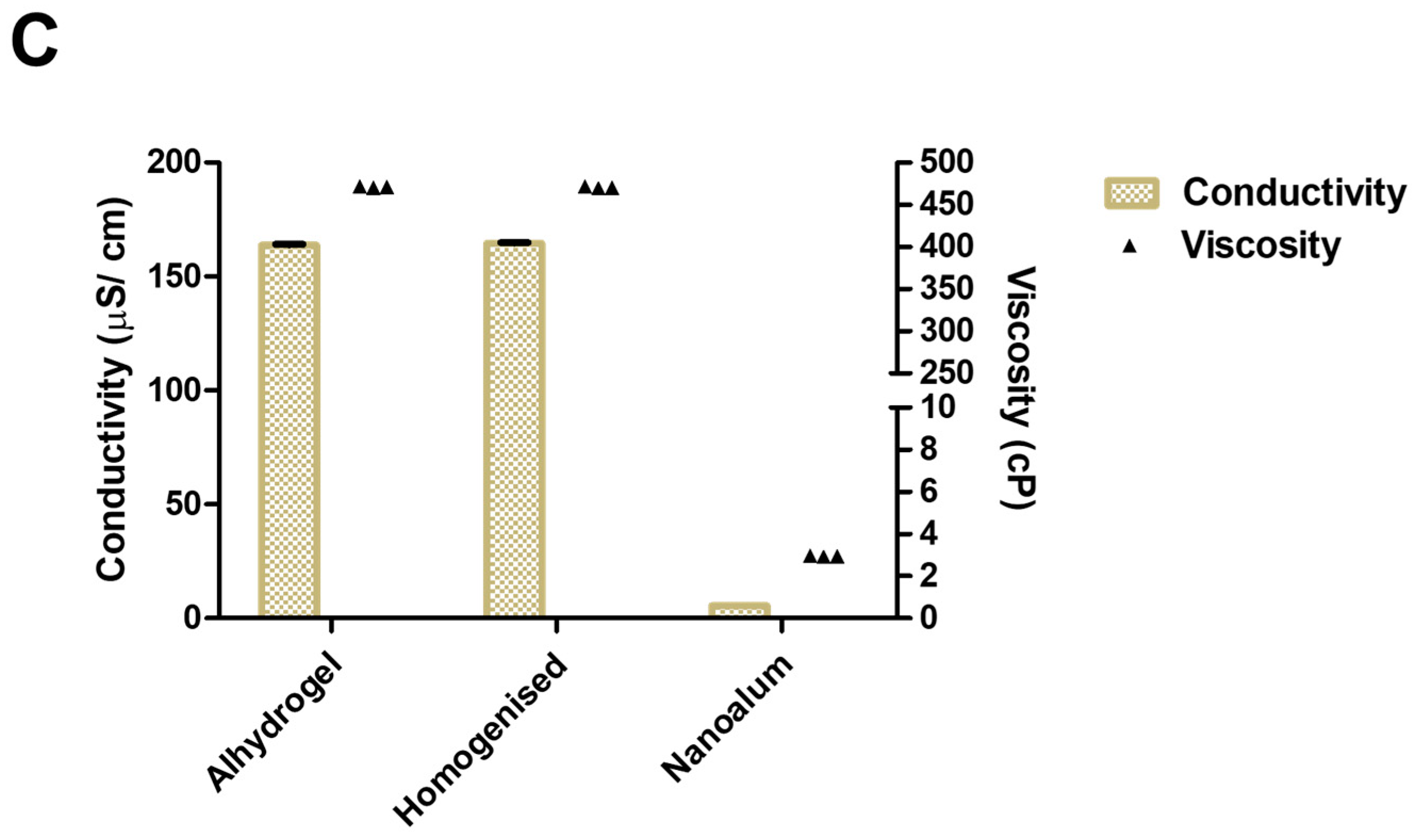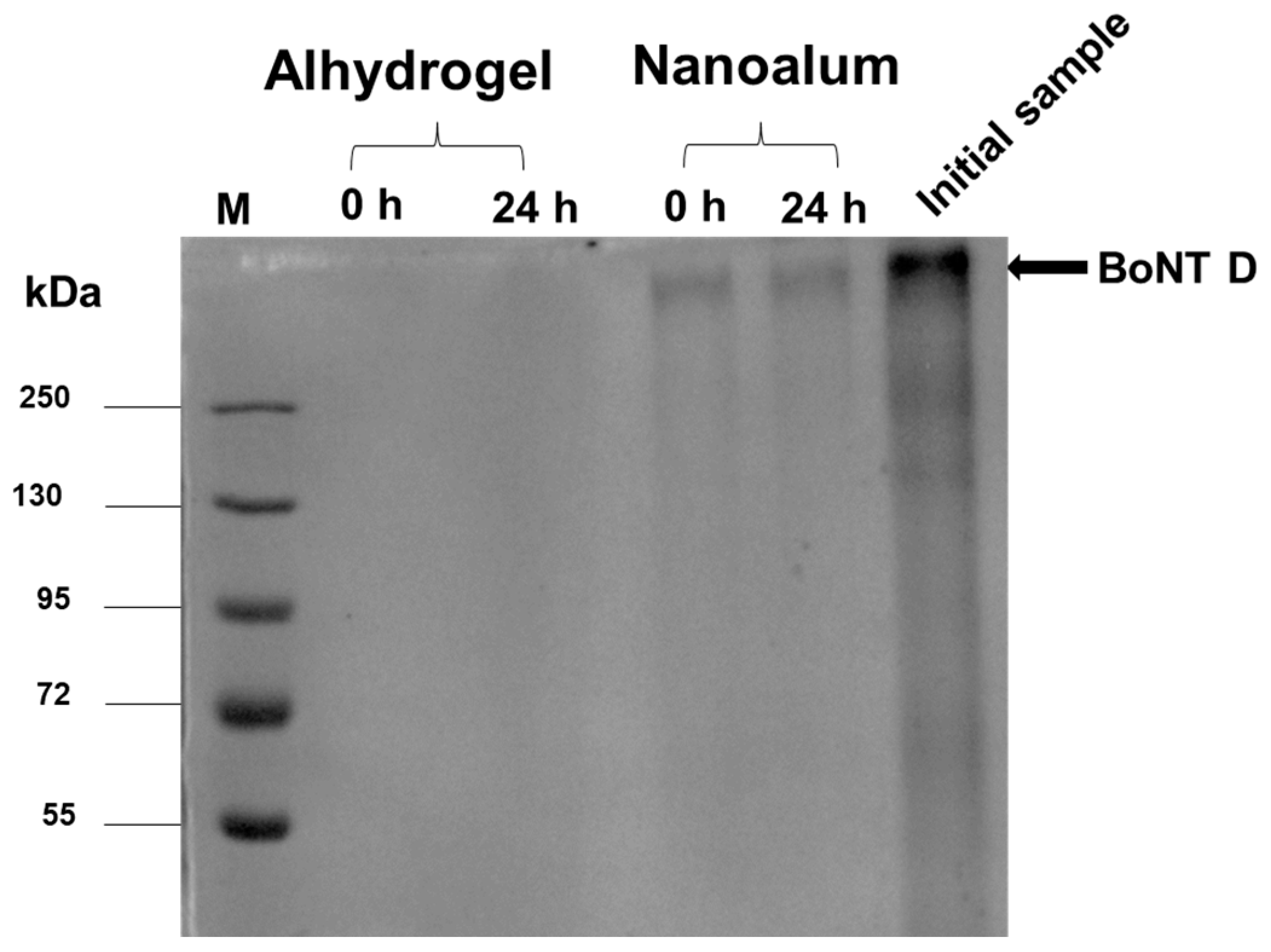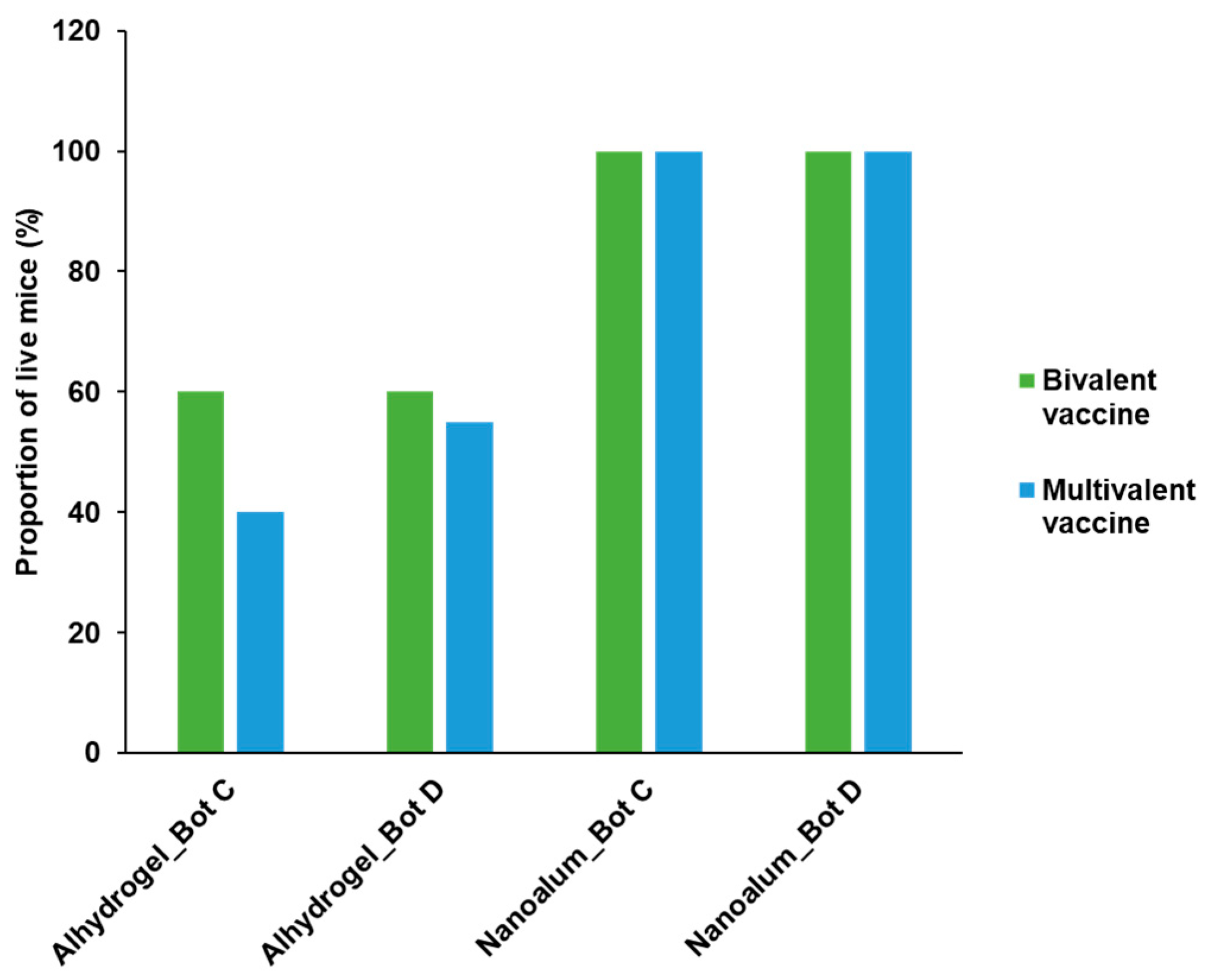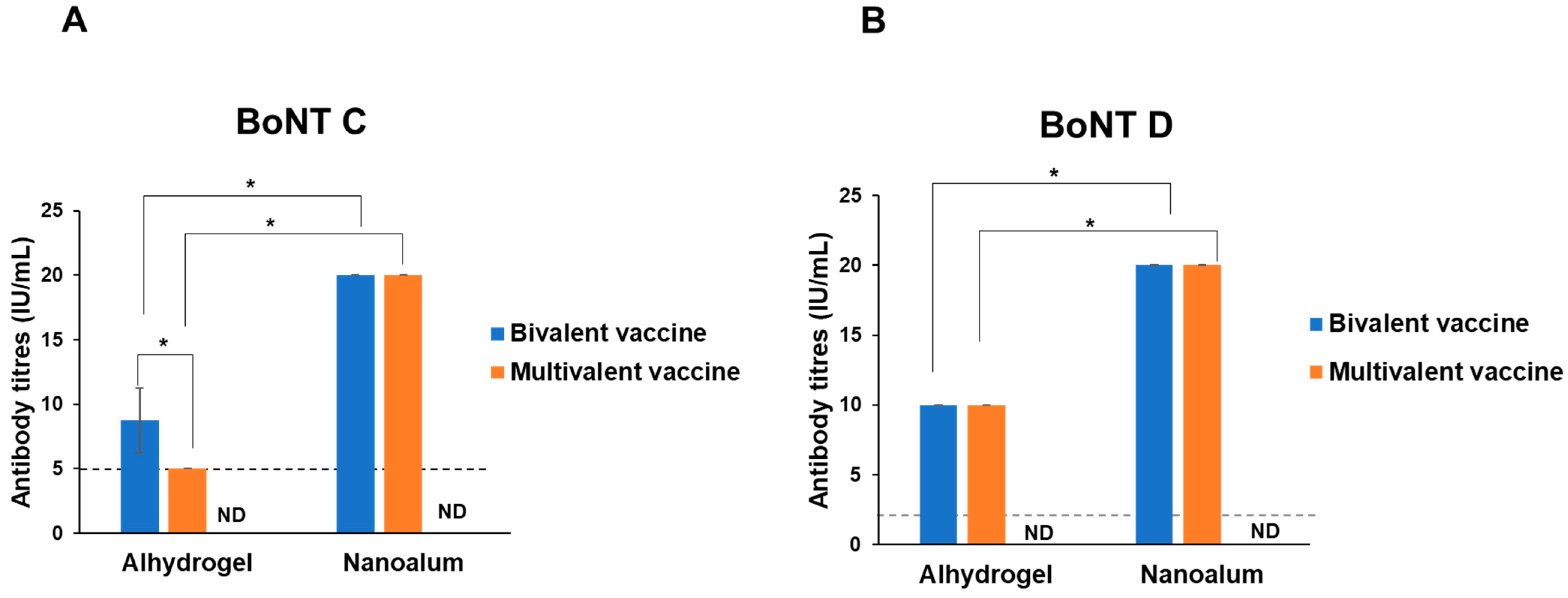Evaluation of Aluminium Hydroxide Nanoparticles as an Efficient Adjuvant to Potentiate the Immune Response against Clostridium botulinum Serotypes C and D Toxoid Vaccines
Abstract
:1. Introduction
2. Materials and Methods
2.1. Preparation and Characterization of Nanoalum
2.2. Adsorption Capacity of Alhydrogel and Nanoalum
2.3. Adjuvant Safety and Vaccine Formulation
2.4. Immunisation of Guinea Pigs
2.5. Evaluation of Neutralising Antibodies
2.6. Statistical Analysis
2.7. Ethics Statement
3. Results
3.1. Preparation and Characterisation of Nanoalum
3.2. Adsorption Capacity of Alhydrogel and Nanoalum
3.3. Evaluation of the Potency of Alhydrogel and Nanoalum Vaccine Formulation
3.3.1. Safety and Protective Efficacy of Alhydrogel- and Nanoalum-Containing Vaccines
3.3.2. Quantification of Toxin-Neutralizing Antibodies
4. Discussion
5. Conclusions
Author Contributions
Funding
Institutional Review Board Statement
Informed Consent Statement
Data Availability Statement
Conflicts of Interest
References
- Smith, L.A. Botulism and vaccines for its prevention. Vaccine 2009, 27, D33–D39. [Google Scholar] [CrossRef] [PubMed]
- Popoff, M.R.; Bouvet, P. Genetic characteristics of toxigenic Clostridia and toxin gene evolution. Toxicon 2013, 75, 63–89. [Google Scholar] [CrossRef] [PubMed]
- Relun, A.; Dorso, L.; Douart, A.; Chartier, C.; Guatteo, R.; Mazuet, C.; Popoff, M.R.; Assié, S. A large outbreak of bovine Botulism possibly linked to a massive contamination of grass silage by type D/C Clostridium Botulinum spores on a farm with dairy and poultry operations. Epidemiol. Infect. 2017, 145, 3477–3485. [Google Scholar] [CrossRef] [PubMed]
- Jabbari, B. Basics of Structure and Mechanisms of Function of botulinum Toxin—How Does it Work? In Botulinum Toxin Treatment; Springer: Cham, Swizerland, 2018; pp. 11–17. [Google Scholar] [CrossRef]
- Steinman, A.; Galon, N.; Arazi, A.; Bar-Giora, Y.; Shpigel, N. Cattle immune response to Botulinum type D toxoid: Results of a vaccination study. Vaccine 2007, 25, 7636–7640. [Google Scholar] [CrossRef]
- Pandian, S.J.; Subramanian, M.; Vijayakumar, G.; Balasubramaniam, G.A.; Sukumar, K. Therapeutic management of Botulism in dairy cattle. Veter. World 2015, 8, 1305–1309. [Google Scholar] [CrossRef]
- Zaragoza, N.E.; Orellana, C.A.; Moonen, G.A.; Moutafis, G.; Marcellin, E. Vaccine Production to Protect Animals Against Pathogenic Clostridia. Toxins 2019, 11, 525. [Google Scholar] [CrossRef]
- Le Maréchal, C.; Hulin, O.; Macé, S.; Chuzeville, C.; Rouxel, S.; Poëzevara, T.; Mazuet, C.; Pozet, F.; Sellal, E.; Martin, L.; et al. A Case Report of a Botulism Outbreak in Beef Cattle Due to the Contamination of Wheat by a Roaming Cat Carcass: From the Suspicion to the Management of the Outbreak. Animals 2019, 9, 1025. [Google Scholar] [CrossRef]
- Moreira, C.; da Cunha, C.E.P.; Moreira, G.M.S.G.; Mendonça, M.; Salvarani, F.M.; Moreira, N.; Conceição, F.R. Protective potential of recombinant non-purified Botulinum neurotoxin serotypes C and D. Anaerobe 2016, 40, 58–62. [Google Scholar] [CrossRef]
- Moreira, C.; Ferreira, M.R.A.; Da Cunha, C.E.P.; Donassolo, R.A.; Finger, P.F.; Moreira, G.M.S.G.; Otaka, D.Y.; De Sousa, L.A.; Barbosa, J.D.; Moreira, N.; et al. Immunogenicity of a Bivalent Non-Purified Recombinant Vaccine against Botulism in Cattle. Toxins 2018, 10, 381. [Google Scholar] [CrossRef]
- Wu, Z.; Liu, K. Overview of vaccine adjuvants. Med. Drug Discov. 2021, 11, 100103. [Google Scholar] [CrossRef]
- Lu, Y.; Liu, G. Nano alum: A new solution to the new challenge. Hum. Vaccines Immunother. 2022, 18, 2060667. [Google Scholar] [CrossRef] [PubMed]
- Amini, Y.; Moradi, B.; Fasihi-Ramandi, M. Aluminum hydroxide nanoparticles show strong activity to stimulate Th-1 immune response against tuberculosis. Artif. Cells Nanomed. Biotechnol. 2017, 45, 1331–1335. [Google Scholar] [CrossRef] [PubMed]
- Liang, F.G.; Lindgren, K.J.; Sandgren, E.A.; Thompson, J.R.; Francica, A.; Seubert, E.; De Gregorio, S.; Barnett, D.T.; O’Hagan, N.J.; Sullivan, R.A.; et al. Vaccine priming is restricted to draining lymph nodes and controlled by adjuvant-mediated antigen uptake. Sci. Transl. Med. 2017, 9, eaal2094. [Google Scholar] [CrossRef]
- Orr, M.T.; Khandhar, A.P.; Seydoux, E.; Liang, H.; Gage, E.; Mikasa, T.; Beebe, E.L.; Rintala, N.D.; Persson, K.H.; Ahniyaz, A.; et al. Reprogramming the adjuvant properties of aluminum oxyhydroxide with nanoparticle technology. NPJ Vaccines 2019, 4, 1. [Google Scholar] [CrossRef] [PubMed]
- Laemmli, U.K. Cleavage of Structural Proteins during the Assembly of the Head of Bacteriophage T4. Nature 1970, 227, 680–685. [Google Scholar] [CrossRef]
- Schantz, E.J.; Kautter, D.A. Standardized Assay for Clostridium botulinum Toxins. J. Assoc. Off. Anal. Chem. 1978, 61, 96–99. [Google Scholar] [CrossRef]
- Gil, L.A.F.; da Cunha, C.E.P.; Moreira, G.M.S.G.; Salvarani, F.M.; Assis, R.A.; Lobato, F.C.F.; Mendonça, M.; Dellagostin, O.A.; Conceição, F.R. Production and evaluation of a recombinant chimeric vaccine against clostridium botulinum neurotoxin types C and D. PLoS ONE 2013, 8, e69692. [Google Scholar] [CrossRef]
- Rosen, O.; Ozeri, E.; Barnea, A.; Ben David, A.; Zichel, R. Development of an Innovative in Vitro Potency Assay for Anti-Botulinum Antitoxins. Toxins 2016, 8, 276. [Google Scholar] [CrossRef]
- Team, R.C.R. A Language and Environment for Statistical Computing, in R Foundation for Statistical Computing; Springer: Vienna, Austria, 2013. [Google Scholar]
- Myllykoski, J.; Lindström, M.; Keto-Timonen, R.; Söderholm, H.; Jakala, J.; Kallio, H.; Sukura, A.; Korkeala, H. Type C bovine Botulism outbreak due to carcass contaminated non-acidified silage. Epidemiol. Infect. 2009, 137, 284–293. [Google Scholar] [CrossRef]
- de Oliveira, C.A.; Duarte, M.C.; de Assis, R.A.; Alves, G.G.; Silva, R.O.S.; Lobato, F.C.F. Humoral responses in cattle to commercial vaccines containing Clostridium perfringens epsilon toxoid and C. botulinum types C and D toxoids last less than a-year. Anaerobe 2019, 59, 72–75. [Google Scholar] [CrossRef]
- Moreira, C.; Ferreira, M.R.; Finger, P.F.; Magalhães, C.G.; Cunha, C.E.; Rodrigues, R.R.; Otaka, D.Y.; Galvão, C.C.; Salvarani, F.M.; Moreira, N.; et al. Protective efficacy of recombinant bacterin vaccine against Botulism in cattle. Vaccine 2020, 38, 2519–2526. [Google Scholar] [CrossRef]
- Morefield, G.L.; HogenEsch, H.; Robinson, J.; Hem, S.L. Distribution of adsorbed antigen in mono-valent and combination vaccines. Vaccine 2004, 22, 1973–1984. [Google Scholar] [CrossRef]
- Hem, S.L.; HogenEsch, H. Relationship between physical and chemical properties of aluminum-containing adjuvants and immunopotentiation. Expert Rev. Vaccines 2007, 6, 685–698. [Google Scholar] [CrossRef]
- Jiang, H.; Wang, Q.; Li, L.; Zeng, Q.; Li, H.; Gong, T.; Zhang, Z.; Sun, X. Turning the Old Adjuvant from Gel to Nanoparticles to Amplify CD8+ T Cell Responses. Adv. Sci. 2018, 5, 1700426. [Google Scholar] [CrossRef] [PubMed]
- He, P.; Zou, Y.; Hu, Z. Advances in aluminum hydroxide-based adjuvant research and its mechanism. Hum. Vaccines Immunother. 2015, 11, 477–488. [Google Scholar] [CrossRef]
- Gupta, R.K. Aluminum compounds as vaccine adjuvants. Adv. Drug Deliv. Rev. 1998, 32, 155–172. [Google Scholar] [CrossRef]
- Bastola, R.; Noh, G.; Keum, T.; Bashyal, S.; Seo, J.-E.; Choi, J.; Oh, Y.; Cho, Y.; Lee, S. Vaccine adjuvants: Smart components to boost the immune system. Arch. Pharmacal Res. 2017, 40, 1238–1248. [Google Scholar] [CrossRef] [PubMed]
- Nazarizadeh, A.; Staudacher, A.H.; Wittwer, N.L.; Turnbull, T.; Brown, M.P.; Kempson, I. Aluminium Nanoparticles as Efficient Adjuvants Compared to Their Microparticle Counterparts: Current Progress and Perspectives. Int. J. Mol. Sci. 2022, 23, 4707. [Google Scholar] [CrossRef] [PubMed]
- Watkinson, A.; Soliakov, A.; Ganesan, A.; Hirst, K.; LeButt, C.; Fleetwood, K.; Fusco, P.C.; Fuerst, T.R.; Lakey, J.H. Increasing the potency of an alhydrogel-formulated anthrax vaccine by minimizing antigen-adjuvant interactions. Clin. Vaccine Immunol. 2013, 20, 1659–1668. [Google Scholar] [CrossRef]
- Chang, M.-F.; Shi, Y.; Nail, S.L.; HogenEsch, H.; Adams, S.B.; White, J.L.; Hem, S.L. Degree of antigen adsorption in the vaccine or interstitial fluid and its effect on the antibody response in rabbits. Vaccine 2001, 19, 2884–2889. [Google Scholar] [CrossRef]
- Morefield, G.L.; Sokolovska, A.; Jiang, D.; HogenEsch, H.; Robinson, J.P.; Hem, S.L. Role of aluminum-containing adjuvants in antigen internalization by dendritic cells in vitro. Vaccine 2005, 23, 1588–1595. [Google Scholar] [CrossRef] [PubMed]
- Kumar, S.; Chaturvedi, V.K.; Kumar, B.; Kumar, P. Immune response and viscosity of haemorrhagic septicaemia oil. Indian J. Anim. Sci. 2011, 8, 1000–1004. [Google Scholar]
- Krüger, M.; Skau, M.; Shehata, A.A.; Schrödl, W. Efficacy of Clostridium botulinum types C and D toxoid vaccination in Danish cows. Anaerobe 2013, 23, 97–101. [Google Scholar] [CrossRef] [PubMed]
- Cunha, C.E.; Moreira, G.M.; Salvarani, F.M.; Neves, M.S.; Lobato, F.C.; Dellagostin, O.A.; Conceição, F.R. Vaccination of cattle with a recombinant bivalent toxoid against Botulism serotypes C and D. Vaccine 2014, 32, 214–216. [Google Scholar] [CrossRef]
- Saadh, M.J.; Sa’Adeh, I.J.; Dababneh, M.F.; Almaaytah, A.M.; Bayan, M.F. Production, immunogenicity, stability, and safety of a vaccine against Clostridium perfringens beta toxins. Veter. World 2020, 13, 1517–1523. [Google Scholar] [CrossRef]
- Li, X.; Aldayel, A.M.; Cui, Z. Aluminum hydroxide nanoparticles show a stronger vaccine adjuvant activity than traditional aluminum hydroxide microparticles. J. Control. Release 2014, 173, 148–157. [Google Scholar] [CrossRef]
- Burny, W.; Callegaro, A.; Bechtold, V.; Clement, F.; Delhaye, S.; Fissette, L.; Janssens, M.; Leroux-Roels, G.; Marchant, A.; Berg, R.A.v.D.; et al. Different Adjuvants Induce Common Innate Pathways That Are Associated with Enhanced Adaptive Responses against a Model Antigen in Humans. Front. Immunol. 2017, 8, 943. [Google Scholar] [CrossRef] [PubMed]







Disclaimer/Publisher’s Note: The statements, opinions and data contained in all publications are solely those of the individual author(s) and contributor(s) and not of MDPI and/or the editor(s). MDPI and/or the editor(s) disclaim responsibility for any injury to people or property resulting from any ideas, methods, instructions or products referred to in the content. |
© 2023 by the authors. Licensee MDPI, Basel, Switzerland. This article is an open access article distributed under the terms and conditions of the Creative Commons Attribution (CC BY) license (https://creativecommons.org/licenses/by/4.0/).
Share and Cite
Mbhele, Z.; Thwala, L.; Khoza, T.; Ramagoma, F. Evaluation of Aluminium Hydroxide Nanoparticles as an Efficient Adjuvant to Potentiate the Immune Response against Clostridium botulinum Serotypes C and D Toxoid Vaccines. Vaccines 2023, 11, 1473. https://doi.org/10.3390/vaccines11091473
Mbhele Z, Thwala L, Khoza T, Ramagoma F. Evaluation of Aluminium Hydroxide Nanoparticles as an Efficient Adjuvant to Potentiate the Immune Response against Clostridium botulinum Serotypes C and D Toxoid Vaccines. Vaccines. 2023; 11(9):1473. https://doi.org/10.3390/vaccines11091473
Chicago/Turabian StyleMbhele, Ziphezinhle, Lungile Thwala, Thandeka Khoza, and Faranani Ramagoma. 2023. "Evaluation of Aluminium Hydroxide Nanoparticles as an Efficient Adjuvant to Potentiate the Immune Response against Clostridium botulinum Serotypes C and D Toxoid Vaccines" Vaccines 11, no. 9: 1473. https://doi.org/10.3390/vaccines11091473
APA StyleMbhele, Z., Thwala, L., Khoza, T., & Ramagoma, F. (2023). Evaluation of Aluminium Hydroxide Nanoparticles as an Efficient Adjuvant to Potentiate the Immune Response against Clostridium botulinum Serotypes C and D Toxoid Vaccines. Vaccines, 11(9), 1473. https://doi.org/10.3390/vaccines11091473






